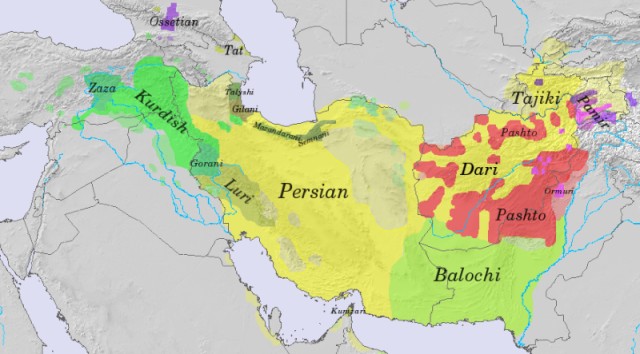
| EASTERN IRANIAN LANGUAGES
Map of modern Iranian languages. The Eastern Iranian languages are shaded red/purple (Pashto, Ossetian, Pamir, Ormuri) Eastern
Iranian :
Subdivisions : Northeastern and Southeastern
The Eastern Iranian languages are a subgroup of the Iranian languages emerging in Middle Iranian times (from c. the 4th century BC). The Avestan language is often classified as early Eastern Iranian.
The largest living Eastern Iranian language is Pashto, with some 50 million speakers between the Oxus River in Afghanistan and the Indus River in Pakistan. As opposed to the Middle Western Iranian dialects, the Middle Eastern Iranian preserves word-final syllables.
Most living Eastern Iranian languages are spoken in a contiguous area, in southern and eastern Afghanistan as well as the adjacent parts of western Pakistan, Gorno-Badakhshan Autonomous Province of eastern Tajikistan, and the far west of Xinjiang region of China. There are also two living members in widely separated areas: the Yaghnobi language of northwestern Tajikistan (descended from Sogdian), and the Ossetic language of the Caucasus (descended from Scytho-Sarmatian). These are remnants of a vast ethno-linguistic continuum that stretched over most of Central Asia, Eastern Europe, and parts of the Caucasus, and West Asia in the 1st millennium BC, otherwise known as Scythia. The large Eastern Iranian continuum in Eastern Europe would continue up to including the 4th century AD, with the successors of the Scythians, namely the Sarmatians.
History
:
With Greek presence in Central Asia, some of the easternmost of these languages were recorded in their Middle Iranian stage (hence the "Eastern" classification), while almost no records of the Scytho-Sarmatian continuum stretching from Kazakhstan west across the Pontic steppe to Ukraine have survived. Some authors find that the Eastern Iranian people had an influence on Russian folk culture.
Middle Persian/Dari spread around the Oxus River region, Afghanistan, and Khorasan after the Arab conquests and during Islamic-Arab rule. The replacement of the Pahlavi script with the Arabic script in order to write the Persian language was done by the Tahirids in 9th century Khorasan. The Persian Dari language spread and led to the extinction of Eastern Iranic languages like Bactrian and Khorezmian, with only a tiny amount of Sogdian descended Yaghnobi speakers remaining among the now Persian speaking Tajik population of Central Asia, due to the fact that the Arab-Islamic army which invaded Central Asia also included some Persians who later governed the region like the Samanids.
Persian was rooted into Central Asia by the Samanids.
Classification
:
The languages are as follows :
Old Iranian
• Scythian and Old Saka†
Avestan† (c. 1000 – 7th century BC) is commonly classified as Eastern, but is not assigned to a branch in this classification.
Middle
Iranian
• Pashto (dialects: Northern, Southern, Central, Yusufzai, Wazirwola, and others)
• North Pamir
•
Sanglechi-Ishkashimi (dialects: Sanglechi, Ishkashimi, Zebaki)
• Ormuri-Parachi (not always considered Eastern Iranian)
• Northern
Lenition
of voiced stops :
A series of spirant consonants can be assumed to have been the first stage: *b > *ß, *d > *ð, *g > *y. The voiced velar fricative /y/ has mostly been preserved. The labial member has been well-preserved too, but in most languages has shifted from a voiced bilabial fricative /ß/ to the voiced labiodental fricative /v/. The dental member has proved the most unstable: while a voiced dental fricative /ð/ is preserved in some Pamir languages, it has in e.g. Pashto and Munji lenited further to /l/. On the other hand, in Yaghnobi and Ossetian, the development appears to have been reversed, leading to the reappearance of a voiced stop /d/. (Both languages have also shifted earlier *0> /t/.)
The consonant clusters *ft and *xt have also been widely lenited, though again excluding Ormuri-Parachi, and possibly Yaghnobi.
External
influences :
Source :
https://en.wikipedia.org/ |
